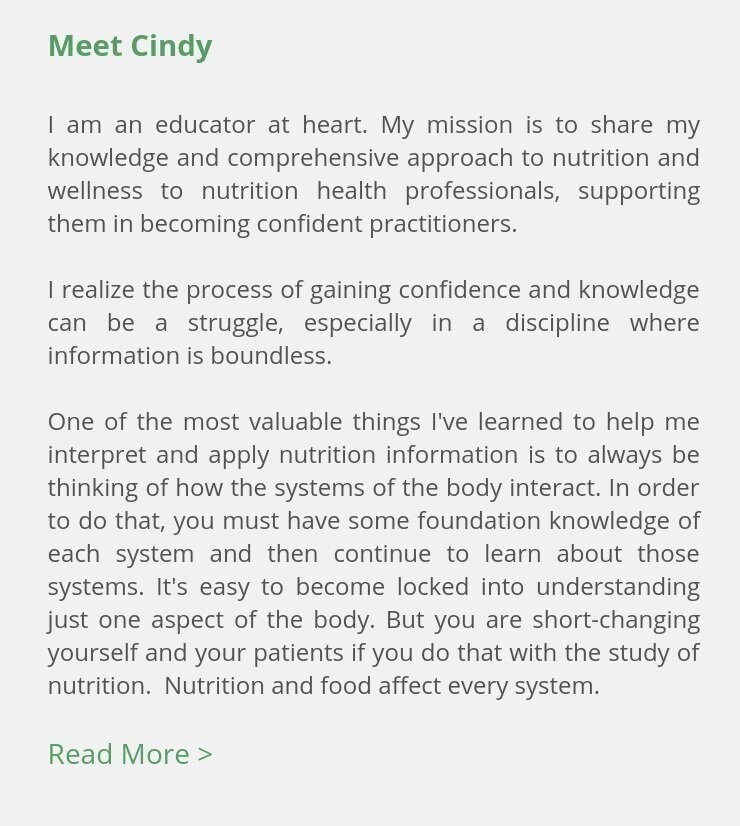
CONFIDENCE IS A RESULT OF PREPAREDNESS
How do you become a “prepared” nutrition practitioner? Effectively applying nutrition knowledge requires a revisit of anatomy and physiology. I became an RD before I became an RN. But, being an RN has made me a better RD— in part, because I have a renewed appreciation of anatomy and physiology.
Nutrition affects all systems of the body. And all systems communicate with one another. A keen understanding of anatomy and physiology of all systems, not just one or two systems catapults your critical thinking around nutrition and the entire body.
“SYSTEMS” TRAINING WILL PREPARE YOU
TO TREAT ANY CLIENT.


The Body Systems
Food and nutrients are absorbed at the cellular level—a.k.a nutritional biochemistry. BUT, all the action in between, from when food enters the mouth and its final products enter the cell, at a minimum, requires a foundational knowledge of the systems of the body. The ultimate destination of nutrients is to provide energy to the cell. Every system in the body is impacted by this fork to cell nutrient travel.
Fork to Cell & in-between
System By System
All that “in between” includes anatomy and physiology. A strong anatomy and physiology foundation enables a methodical, systematic nutrition assessment. You can’t have the cellular biochemistry part without the anatomy and physiology part.
Becoming more systems savvy enables a better understanding of how nutrients, supplements and botanicals impact every system.
Becoming more systems savvy enables you to more accurately assess biomarkers and labs.
Improved structure and function knowledge of each system enables better understanding of how systems communicate.
Every system is influenced by the gut microbiome and genes.
Absolutely loving your course!
Thank you for creating!
So glad I purchased!
Exactly what I needed!
I had been a conventionally trained Registered Dietitian for a number of years and through my own health journey became convinced of the benefit of getting to the root cause for optimal health. I wanted to understand how to cultivate healthy functioning through nutrition but after completing several modules in another integrative/functional nutrition training program, I was struggling to hold all the new information together and have a working knowledge I could apply to patient care.
Cindy’s Systems Biology and Functional Nutrition course provided me with exactly what I needed: a framework to understand the body as a working unit as nutrition impacts the whole body. I had a lens /system to think through and problem solve the situation for each patient to utilize what I knew and the new frameworks to become a detective to find what works for my patients and go to the research myself when I needed to..
I completed the course over several months while I worked fulltime picking up the course when I had a break in patient care. She uses different modalities to facilitate learning and have things “stick”. I saved several thousands of dollars by completing Cindy’s course by not feeling I needed to complete additional modules of further training to have the learning I needed to practice as a functional dietitian.
Mary Gannon Kaufmann, MS, RDN, MA, BCC (Board Certified Healthcare Chaplain)
“I highly recommend this comprehensive, evidence-based overview of nutrition and systems. The format connects the important aspects of physiology, biometrics and food/supplements. I am hopeful a systems approach becomes standard in practice in the future.”
Joanne Gooley, MA, RD
TESTIMONIALS
“The extensive review of medical publications alone is a daunting task; organizing them into a program that seamlessly flows, as demonstrated here, is notable. I professionally appreciate the level of expertise and the amount of time that it took Cindy to deliver such an exceptional program. Cindy has taken the extraordinary complexities of the body, condensed them, and concisely integrated them into a comprehensive program that has been thoroughly researched.”
Sophia Kamveris, MS, RND
“The contents of this course is evidence-based and well referenced. Cindy identifies & describes structure & function of eight systems with expertise & depth of knowledge that comes from years of clinical experience & practice. Applies nutritional biochemistry within each system with an understanding of digestion, absorption & utilization of nutrients within a healthy system and within disease states.”
Melissa Snow, MS, RDN
“The information is very clearly presented at an appropriate level for a dietitian. Very organized and thorough with good flow. Really appreciated the Key Takeaways at the end of each section. Presents very scientifically valid information. I truly appreciated the depth of the course and bonus materials.”
Michelle Tasker, RDN, LDN, CLT























